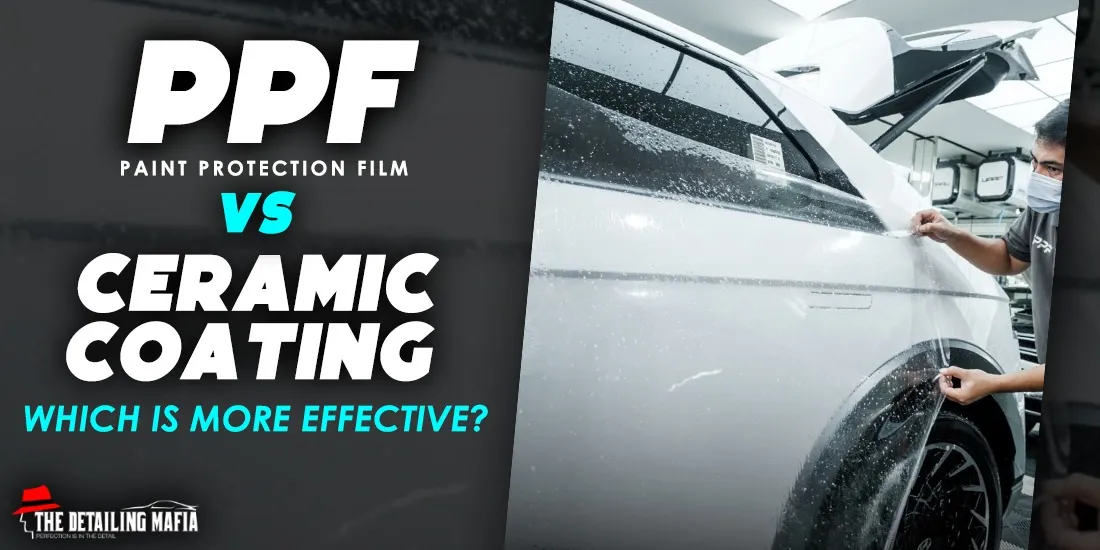

When it comes to protecting your vehicle's paintwork, two popular options are often considered: PPF (Paint Protection Film) and ceramic coating. Both offer benefits in terms of durability, protection, and enhancing the aesthetics of your car. However, it's important to understand the differences between the two to determine which option is more effective for your specific needs. In this blog post, we will explore the characteristics, advantages, and considerations of PPF and ceramic coating to help you make an informed decision.
What is Paint Protection Film (PPF)?
PPF, or Paint Protection Film, is a transparent, self-healing film that is applied to the exterior surfaces of a vehicle. It is typically made from thermoplastic urethane and is designed to protect against scratches, rock chips, insect stains, and other physical damage. PPF acts as a sacrificial layer, absorbing impacts and preventing damage to the underlying paintwork.
Advantages of Paint Protection Film (PPF)
1. Superior Impact Resistance:
PPF provides excellent protection against rock chips, scratches, and road debris. Its self-healing properties enable minor scratches to disappear over time, keeping the film and underlying paintwork in pristine condition.
2. Protection Against Environmental Factors:
PPF shields your vehicle from harmful UV rays, oxidation, bird droppings, and chemical stains. It helps maintain the original paint colour, preventing fading or discoloration caused by prolonged sun exposure.
3. Invisible Protection:
PPF is nearly invisible when properly installed, allowing the beauty of your vehicle's paintwork to shine through without altering its appearance. It offers a clear, glossy finish that enhances the aesthetics of your car.
4. Longevity:
PPF is known for its durability, typically lasting for several years. It is resistant to fading, yellowing, and degradation, ensuring long-term protection for your vehicle.
Considerations For PPF
Cost: |
PPF installation can be more expensive than ceramic coating due to the material costs and labor-intensive installation process. However, the level of protection and peace of mind it offers may outweigh the initial investment for many car owners. |
Professional Installation: |
Proper installation of PPF requires skill and expertise. It is recommended to have it professionally installed by experienced technicians to ensure a seamless fit and maximum protection. |
What is Ceramic Coating?
Ceramic coating, also known as nano-ceramic coating, is a liquid polymer that is applied to the vehicle's paintwork. It chemically bonds with the surface, creating a protective layer that enhances gloss, repels water and contaminants, and provides long-lasting protection against UV rays and environmental damage.
Advantages of Ceramic Coating:
1. High Gloss and Enhanced Aesthetics:
Ceramic coating enhances the depth and gloss of the paint, giving your vehicle a sleek, showroom-like finish. It provides a hydrophobic effect, causing water to bead and roll off, resulting in a self-cleaning effect.
2. Chemical and UV Resistance:
Ceramic coating forms a protective barrier against chemicals, UV rays, and oxidation. It helps prevent paint fading, discoloration, and damage caused by harsh environmental factors.
3. Easy Maintenance:
Ceramic coating reduces the adhesion of dirt, dust, and contaminants to the paint surface, making it easier to clean and maintain. It also offers resistance to water spots and stains, prolonging the cleanliness of your vehicle.
4. Longevity:
With proper care, ceramic coating can provide long-lasting protection, typically lasting for several years. It eliminates the need for frequent waxing or sealing, saving you time and effort.
Considerations For Ceramic Coating:
| Scratch Resistance: | While ceramic coating provides a sacrificial layer against light scratches, it is not as effective as PPF in preventing deep scratches or rock chips. It offers limited impact resistance compared to the physical barrier provided by PPF. |
| Surface Preparation: | Proper surface preparation is crucial for achieving optimal results with ceramic coating. The paintwork must be thoroughly cleaned, decontaminated, and polished before applying the coating to ensure proper bonding and durability. |
| Professional Application: | Ceramic coating requires precise application techniques to achieve uniform coverage and ensure maximum effectiveness. It is advisable to have it professionally applied to guarantee the best results. |
Choosing the Right Protection for Your Vehicle:
Choosing between PPF and ceramic coating depends on your specific needs and preferences. If you prioritize superior impact resistance and physical damage protection, PPF may be the ideal choice. However, if you are looking for an enhanced gloss, ease of maintenance, and protection against environmental factors, the ceramic coating may be more suitable.
In some cases, a combination of both PPF and ceramic coating may be preferred, where PPF is applied to high-impact areas, such as the front bumper and hood, while the rest of the vehicle is treated with ceramic coating.
Conclusion:
PPF and ceramic coating are both effective options for protecting your vehicle's paintwork. PPF offers superior impact resistance and physical damage protection, while ceramic coating provides enhanced gloss, ease of maintenance, and protection against environmental factors. Understanding the characteristics and considerations of each option is essential in making an informed decision. Consider your priorities, budget, and desired level of protection to determine whether PPF, ceramic coating, or a combination of both is the right choice for your vehicle. Ultimately, investing in the right protection will help preserve your vehicle's appearance and maintain its value for years to come.
To get one done on your car or enquire more:
Visit: https://www.thedetailingmafia.com/
Call: +91-80-100-44000 OR +91-92-894-44440
